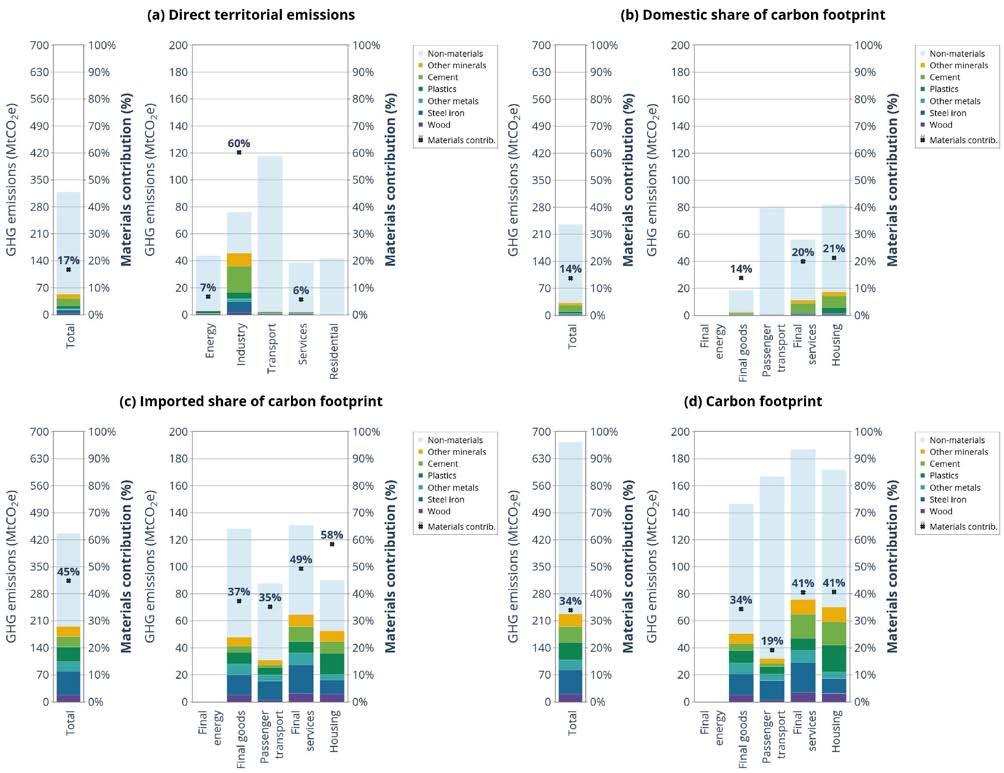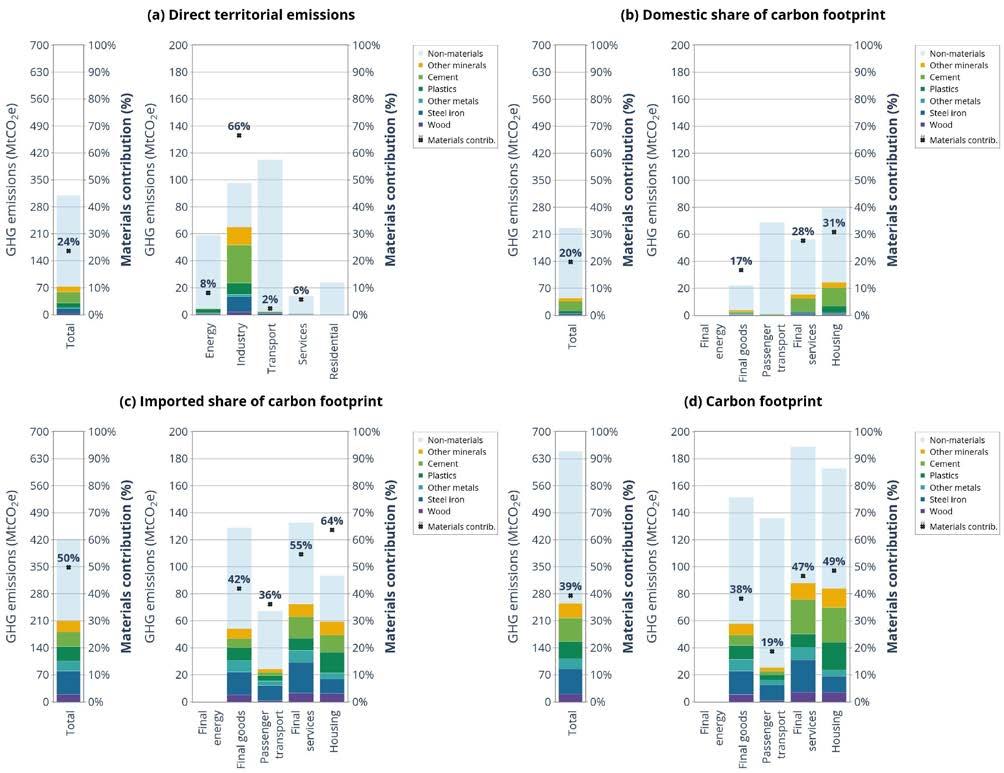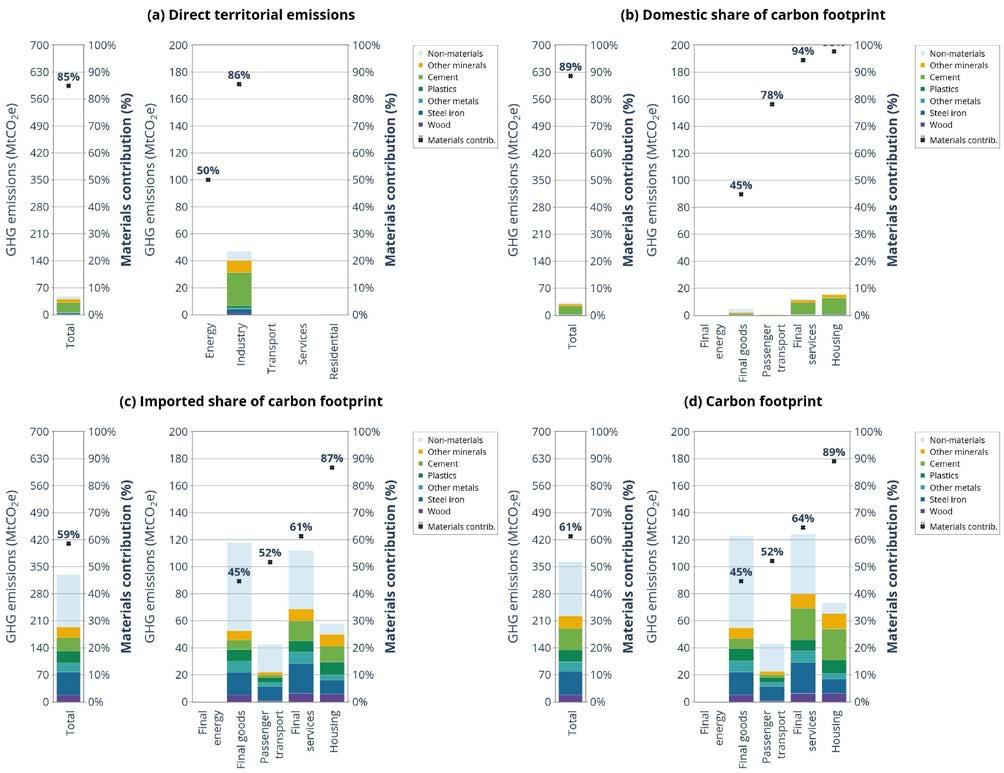
10 minute read
2. Discussion
2.1 Towards more sustainable low carbon strategies
We found that the CFM in France amounted to 3.4 tCO2e/cap in 2015 (34% of total carbon footprint) compared to only 0.8 tCO2e/cap (53 MtCO2eq) for territorial emissions from material supply. Therefore, the CFM should be a main focus of low carbon strategies and climate policy. The novel framework developed here allows to map the CFM across supply chains and trade, assess the impact of low carbon strategies on the CFM and identify levers for further reducing the CFM towards climate neutrality at national scale. We show on the case of France that although current national NZE strategy could massively reduce territorial emissions and almost halve total carbon footprint, it would leave the CFM basically untouched (both territorial and imported emissions) by 2050. In fact, the load of materials production on GHG emissions especially remains at the background of final services wrongly thought of being sustainable and dematerialized. We conclude that the CFM is a main blind spot of current national strategy and additional measures are needed to tackle the CFM towards more sustainable footprints. We have further provided a detailed mapping of the carbon footprint and main determinants of the unabated CFM across supply chains. Based on this analysis, we discuss here additional policies to tackle the CFM at three different levels: (i) border policies supporting imports of clean industrial products at the national level, (ii) relocating low-carbon industrial productions next to material efficiency and circular economy policies, (iii) fostering low-energy an low-material demand patterns.
We have assumed here moderate climate policies in foreign trade partners (NDCs) to isolate the effects of domestic policies, but many countries have enacted more ambitious goals and similar NZE commitments than France by mid-century4. Keeping a high import dependency, the issue at stake is the speed of decarbonization in countries where imported goods are produced. Even if trade partners follow a track towards NZE by mid-century, a transitional state will remain around 2030 and 2040 with a high carbon content of imports, even after the emission peak28,29. Canceling the CFM from the cradle implies full decarbonization of the production of materials and associated energy supply. However, the potential for a fast transition to zero-carbon industrial processes and materials as required is still uncertain, all the more in developing countries producing most materials18,19. In addition, these countries might prioritize decarbonization of their domestic energy services, over that of their materials production. Overall, coordination and cooperation between importing and exporting countries are required to ensure the feasibility of carbon footprint neutrality: (i) North-South monetary transfers to support faster decarbonization of abroad industrial apparatus ; (ii) The implementation of a carbon tax at the border to encourage imports of low carbon manufacturing goods ; (iii) The development of climate clubs to ensure the broader cooperation and collaboration between countries allowing the endogenization of whole supply chains within national climate policies35. However, those options are dependent on the willingness of trade partners to follow them collectively and recent experiences have demonstrated the difficulty to do so. Thereafter, we discuss complementary levers that can be activated domestically to cancel the CFM.
The CFM is composed of imported manufacturing goods for the most part. Extending energy self-sufficiency as planned by the NZE strategy to manufacturing goods might be an effective option to reduce imported emissions. However, it would require adequate low-carbon domestic production capacities to substitute domestic production from imports. In a linear economy following the “take-make-dispose” principle, it especially requires raw materials, which are missing in countries like France. However, shifting to a circular economy viewpoint opens up new opportunities for relocation and reindustrialization while decreasing the CFM. Western countries like France have developed based on imports of materials and durable goods from other countries during last decades30. They have accumulated a stock of capital generating enough waste that could be turned into the main resources for the next few decades36. More concretely, three main types of circular economy strategies37–39 could contribute to decreasing the CFM and decouple economic activity from material extraction: closing supply chains (recycling, reuse, remanufacturing); product lifetime extension (more durable goods, repairing) and resource efficiency (process and design improvements, sharing, etc.). However, the world economy is still only 6% circular40. Moving towards circularity will imply deep structural changes and industrial reorganization around new innovative technology clusters and supply chains.
Eventually, reducing domestic final demand for materials and manufacturing is a needed complementary way to reach carbon footprint neutrality by mid-century. Low-energy demand (LED) policies have demonstrated their potential to provide equivalent energy services more efficiently while reducing the demand for energy and new infrastructures and equipment39,41. It enables a reduction in the demand for imported manufacturing goods while reducing imported GHG emissions. Deploying LED patterns allows to decrease the demand for energy next to capital goods, which can facilitate the transition to a local circular economy.
Using a case study on France allowed us to propose a fine analysis of value chains for the whole economy (Fig. 4), isolate key determinants of CFM, and draw up a list of recommendations for public policies. We believe these guidelines stand for many western countries with similar characteristics, i.e. high CFM, low direct territorial emissions from materials production, and high trade deficit regarding manufacturing goods. Our framework is applicable to any other countries and based on a modeling platform MatMat in the process of being put in open-source. Beyond the general policy conclusions that can be drawn from the case of France, country specific analysis is needed to differentiate policy recommendations and derive domestic policies tailored to the particular structure of the CFM across supply chains and trade.
2.2 Methods
Our study involved an hybrid Input-Output (IO) model called MatMat we developed20 based on extending existing works7,8,21–23 and following key modeling principles of the IE community24,25 allowing flexibility, reproduction, and transposition to other case studies. It aims to fill existing gaps between Integrated Assessment Modelling (IAM) and Industrial Ecology (IE) communities10,17 about global supply chains and the life-cycle perspective of future energy and materials systems at a national scale. In particular, it has been designed (i) to perform static analysis of the current economy but also prospective studies through the integration of exogenous scenarios from various sets of expertise about low-carbon scenarios, (ii) to disentangling the link between GHG emissions, investments demand and materials production along the supply chains from abroad and domestic producers to final domestic energy services. In particular, the consumption-based scheme includes an endogenization of capital and the carbon footprint of materials is assessed using the Hypothetical Extraction Method (HEM)7,8
Departing from the Environmental Extended IO (EEIO) database Exiobase v3.723, we built a hybrid IO calibration database for our french case study based on a multi-layer approach42: energy fluxes are expressed in in k.tep, and GHG emissions in MtCO2e. Note that we integrate the six main GHG about fossil fuels combustion and industrial processes. We exclude emissions from land-use change and agriculture as link between them and materials supply is not straightforward. We complete this dataset using KLEMS database to desegregate investment vector in a square matrix7,43 and Eurostat databases to refine the quality of the physical fluxes, in particular about the energy balance.
Our model proposes an innovative method to build to prospective scenarios (e.g. the transition to Net-Zero emissions). It enables to integrate and reconcile at meso level various sets of expertise about the low-carbon transition from micro-scale (e.g. outcomes from energy models) to macro-scale (e.g. findings from macroeconomic models). In particular, MatMat provides a parametrization interface about (i) material, energy, carbon, and capital content of domestic production and imports, (ii) the evolution of final consumer and investment demands, and (iii) the change in trades. In the current study, the parametrization for prospective analysis by 2050 is built from bottom-up and macroeconomic expertises of the French governmental NZE scenario26,26 and a global mitigation scenario28,29. The national scenario encompasses (i) macroeconomic drivers from ThreeME macroeconomic model44, (ii) a complete description of energy efficiency gains in each economic sector from the energy model MedPro (https://www.enerdata.fr/ research/), (iii) investment chronicles in low-carbon infrastructures and equipment (https://www.i4ce.org/ theme_travail/investir-pour-le-climat-et-financer-la-transition/). The worldwide scenario includes a set of key parameters from the Imaclim-R World model45 to describe indirect GHG emissions embodied in imports, i.e. energy efficiency gains and carbon content.
References
Aguilar-Hernandez, G. A., Sigüenza-Sanchez, C. P., Donati, F., Rodrigues, J. F. D. and Tukker, A. (2018) Assessing circularity interventions: a review of EEIOAbased studies. Journal of Economic Structures 7, 14
Azevedo, I., Bataille, C., Bistline, J., Clarke, L. and Davis, S. (2021) Netzero emissions energy systems: What we know and do not know. Energy and Climate Change 2, 100049.
Bibas, R. et al. (2016) IMpact Assessment of CLIMate policies with IMACLIM-R 1.1. Model documentation version 1.1.
Bouckaert, S. et al. (2021) Net Zero by 2050: A Roadmap for the Global Energy Sector https://www.iea.org/reports/netzero-by-2050
Callonnec, G., Landa, G., Malliet, P., Reynès, F. & YeddirTamsamani, Y. (2013) A full description of the Three-ME model: Multi-sector Macroeconomic Model for the Evaluation of Environmental and Energy policy.
Ekins, P. et al. (2016) Resource Efficiency: Potential and Economic Implications.
Elkerbout, M., Bryhn, J., Righetti, E. & Chapman, F. (2022) From carbon pricing to climate clubs: How to support global climate policy coordination towards climate neutrality
Elshkaki, A., Graedel, T.E., Ciacci, L. and Reck, B.K. (2018) Resource Demand Scenarios for the Major Metals. Environmental Science & Technology 52, 2491–2497
Fisch-Romito, V. (2021) Embodied carbon dioxide emissions to provide high access levels to basic infrastructure around the world. Global Environmental Change 70, 102362
Grubler, A. et al. (2018) A low energy demand scenario for meeting the 1.5 °C target and sustainable development goals without negative emission technologies. Nature Energy 3, 515–527
Haas, W., Krausmann, F., Wiedenhofer, D. and Heinz, M. (2015) How Circular is the Global Economy?: An Assessment of Material Flows, Waste Production, and Recycling in the European Union and the World in 2005. Journal of Industrial Ecology 19, 765–777 (2015).
Harris, P.G. and Symons, J. Norm (2013) Conflict in Climate Governance: Greenhouse Gas Accounting and the Problem of Consumption. Global Environmental Politics 13, 9–29.
Haut-Commissariat au Plan (2021) Reconquête de l’appareil productif : la bataille du commerce extérieur.
Hertwich, E.G. and Wood, R. (2018) The growing importance of scope 3 greenhouse gas emissions from industry. Environmental Research Letters 13, 104013
Hertwich, E.G. et al. (2018) Nullius in Verba1: Advancing Data Transparency in Industrial Ecology. Journal of Industrial Ecology 22, 6–17
Hertwich, E.G. et al. (2019)
Material efficiency strategies to reducing greenhouse gas emissions associated with buildings, vehicles, and electronics a review.
Environmental Research Letters 14, 043004
Hertwich, E.G. et al. (2020)
Resource efficiency and climate change: Material efficiency strategies for a low-carbon future
Hertwich, E.G. (2021) Increased carbon footprint of materials production driven by rise in investments. Nature Geoscience 14, 151–155.
Iyer, G. et al. (2021) The role of carbon dioxide removal in netzero emissions pledges. Energy and Climate Change 2, 100043
Kennedy, C. (2020) Energy and capital. Journal of Industrial Ecology 24, 1047–1058
Keppo, I. et al. (2021) Exploring the possibility space: taking stock of the diverse capabilities and gaps in integrated assessment models. Environmental Research Letters 16, 053006
Krausmann, F., Wiedenhofer, D. and Haberl, H. (2020) Growing stocks of buildings, infrastructures and machinery as key challenge for compliance with climate targets. Global Environmental Change 61, 102034
Luderer, G. et al. (2018) Residual fossil CO2 emissions in 1.5–2°C pathways. Nature Climate Change 8, 626–633.
Magalhães, N. et al. (2019) The Physical Economy of France (1830–2015). The History of a Parasite? Ecological Economics 157, 291–300.
Merciai, S. (2019) An input-output model in a balanced multi-layer framework. Resources, Conservation and Recycling 150 104403
Ministère de la Transition Écologique (2015) Loi Transition Énergétique Pour la Croissance Verte n° 2015-992 du 17 août 2015.
Ministère de la Transition Écologique (2020) Stratégie Nationale Bas-Carbone.
Ministère de la Transition Écologique (2021) Loi Climat et Résilience n° 2021-1104 du 22 août 2021.
Müller, D.B. et al. (2013). Carbon Emissions of Infrastructure Development. Environmental Science & Technology 47, 11739–11746
OCDE (2019) Global Material Resources Outlook to 2060
Pauliuk, S., Majeau-Bettez, G., Mutel, C.L., Steubing, B. and Stadler, K. (2015) Lifting Industrial Ecology Modeling to a New Level of Quality and Transparency: A Call for More Transparent Publications and a Collaborative Open Source Software Framework. Journal of Industrial Ecology 19, 937–949 25.
Pauliuk, S., Arvesen, A., Stadler, K. & Hertwich, E.G. (2017) Industrial ecology in integrated assessment models. Nature Climate Change 7, 13–20.
Pauliuk, S. (2018) Critical appraisal of the circular economy standard BS 8001:2017 and a dashboard of quantitative system indicators for its implementation in organizations. Resources, Conservation and Recycling 129, 81–92
Sluisveld, M.A.E. van, de Boer, H.S., Daioglou, V., Hof, A.F. and van Vuuren, D.P. (2021) A race to zero - Assessing the position of heavy industry in a global net-zero CO2 emissions context. Energy and Climate Change 2, 100051
Södersten, C.-J.H., Wood, R. and Hertwich, E.G. (2018) Endogenizing Capital in MRIO Models: The Implications for Consumption-Based Accounting. Environmental Science & Technology 52, 13250–13259.
Stadler, K. et al. (2018) EXIOBASE 3: Developing a Time Series of Detailed Environmentally Extended Multi-Regional InputOutput Tables. Journal of Industrial Ecology 22, 502–515
Stadler, K. Pymrio (2021) A Python Based Multi-Regional Input-Output Analysis Toolbox. Journal of Open Research Software, 9 https://librairie.ademe.fr/change ment-climatique-etenergie/3880-construction-dematrices-de-flux-de-matierespour-une-prospective-integreeenergie-matieres-economie.html
Stehrer, R. wiiw (2021) Growth and Productivity Data.
Teixeira, A., Lefèvre, J., Saussay, A. & Vicard, F. (2020) Construction de matrices de flux de matières pour une prospective intégrée énergie-matières-économie: Revue de littérature et cadrage méthodologique pour le développement du modèle MatMat.
Tsiropoulos, Nijs, Tarvydas and Ruiz Castello (2020)
Towards net-zero emissions in the EU energy system by 2050” doi: 10.2760/081488 (online), 10.2760/062347 (print).
UN-FCCC (2021) Adoption of the Paris agreement (2015). European Union. European climate law. Regulation 2021/1119 of the European Parliament and of the Council of 30 June 2021 establishing the framework for achieving climate neutrality and amending Regulations (EC) No 401/2009 and (EU) 2018/1999
Vrontisi, Z. et al. (2018) Enhancing global climate policy ambition towards a 1.5 °C stabilization: a short-term multi-model assessment. Environmental Research Letters 13, 044039
Wiebe, K.S., Bjelle, E.L., Többen, J. and Wood, R. (2018) Implementing exogenous scenarios in a global MRIO model for the estimation of future environmental footprints. Journal of Economic Structures 7, 20
Wood, R. et al. (2020) The structure, drivers and policy implications of the European carbon footprint. null 20, S39–S57.
Note: Emissions are given for each variable by total (left) and sectoral breakdown (right). Beyond, emissions are broken down to show the contribution of the production of each material. This breakdown is given in MtCO2es and represented by the bar plot (left y-axis), while the contribution of all materials is given in percentage by the black cross scatter plot (right y-axis).
Note: Emissions are given for each variable by total (left) and sectoral breakdown (right). Beyond, emissions are broken down to show the contribution of the production of each material. This breakdown is given in MtCO2eq and represented by the bar plot (left y-axis), while the contribution of all materials is given in percentage by the black cross scatter plot (right y-axis).

Note: Emissions are given for each variable by total (left) and sectoral breakdown (right). Beyond, emissions are broken down to show the contribution of the production of each material. This breakdown is given in MtCO2eq and represented by the bar plot (left y-axis), while the contribution of all materials is given in percentage by the black cross scatter plot (right y-axis).




